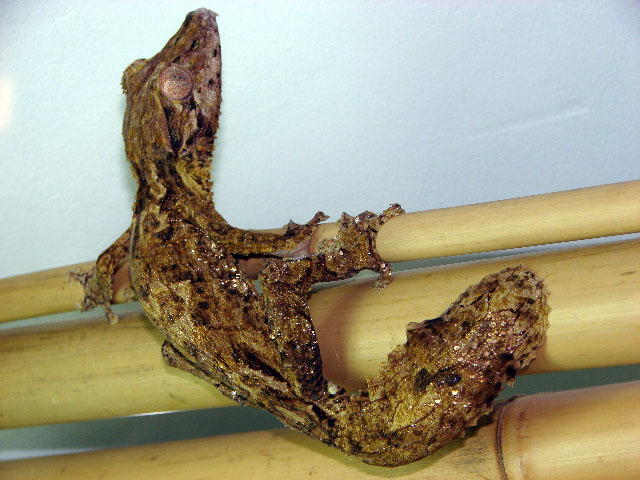A 4-year-old Henkel’s leaf-tailed gecko was treated for skin cancer at the Smithsonian National Zoo and Conservation Biology Institute, the zoo announced April 17 in a news story on its website.
A 4-year-old Henkel’s leaf-tailed gecko (Uroplatus_henkel) was treated for skin cancer at the Smithsonian National Zoo and Conservation Biology Institute, the zoo announced April 17 in a news story on its website.
Keepers at the zoo were conducting a routine checkup on the reptile when they noticed a small discolored bump on the gecko’s neck. The gecko shed its skin, and the lump disappeared at first, but then regrew back, along with a second growth as well as black spots around the affected area. The growth was diagnosed as squamous cell carcinoma, a form of skin cancer that can be deadly in humans.
Dr. Laci Taylor and Dr. James Steeil, veterinarians at the zoo had to make a decision. The tumor was directly above the gecko’s spine, which would make the surgery particularly dangerous, and with no guarantee that the surgery to remove the cancerous growth would grow back, or look for another form of treatment. Palliative care was ruled out as the gecko was in good physical shape and otherwise healthy despite the cancer.
The doctors, through research, found a case study that involved treating a cockatiel with the same cancer via a chemotherapy regimen using the drug Bleomycin, an injectable chemotherapy drug. The doctors agreed this form of treatment was the best way forward, and the gecko’s pleasant demeanor and handleability led the team to believe it would be less stressed during the chemotherapy regimen.
“The growths could be painful. It wasn’t something we wanted to sit around and watch,” Matt Evans, assistant curator of the Zoo’s Reptile Discovery Center exhibit said in the zoo’s story covering the lizard’s plight. “But this gecko was stable and healthy overall and doing all the normal things a gecko should. That made it easier for us to say, ‘okay, this animal’s pretty strong, let’s see.’”
Because of the small size of the gecko, the vet staff fashioned a tiny face mask to deliver the anesthesia, and the heart was monitored using a sound-based Doppler probe. The chemotherapy drug was administer directly into the tumors. The team then used electrochemotherapy device to pulse electricity into the affected tissue, which opened the cell membranes to increase the amount of the drug into the infected cells. The procedure was overseen by veterinary oncologist Dr. Conor McNeill, who advised both on the procedure and provided the equipment and the drugs used in the procedure. The vet staff closed up the wounds and sent the gecko to the zoo’s hospital recovery ward.
The gecko is now living in its enclosure and is eating a full diet, looks strong and most importantly there are no signs of the lesion. The zoo staff is hoping that the treatment is fully successful, which would add years to the gecko’s life. Additionally, the treatment will serve as a model for other reptiles that may have squamous cell carcinomas.
“There’s a lot we don’t know about reptile medicine simply because most of these drugs haven’t been used on reptiles. If this treatment does its job, we’ll have a better idea how to move forward,” Evans said.
The Henkel’s leaf-tailed gecko is also known as the Henkel’s flat-tailed gecko and the frilled leaf-tailed gecko. It is native to Madagascar and is a mostly arboreal species. It does go down to lay eggs in soft soil and leaf litter, but is otherwise arboreal. They are insectivores and feed on insects. It is listed as vulnerable by the IUCN due to habitat destruction and deforestation on Madagascar.



